Pigs
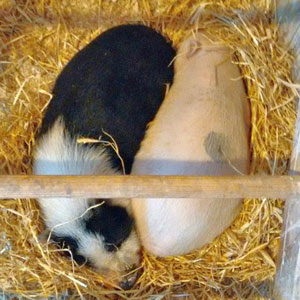
Did you know pigs are smart, industrious and affectionate?
The pigs at Safe Haven Farm Sanctuary are visitors’ favorites. They love having their bellies and ears rubbed; they are always curious about what is going on around them.
Recent scientific studies have confirmed that pigs are the smartest of domesticated animals, smarter than cats and dogs. Amazingly, pigs:
- Live in social communities, recognize individuals, cooperate, and learn from each other;
- Have excellent long term memories;
- Are good at problem solving, such as mazes, using a mirror to find hidden food, and locating objects;
- Can use a joystick to play computer games;
- Understand simple words and can learn complex combinations of symbols for objects;
- Are smarter than a three year old human child.
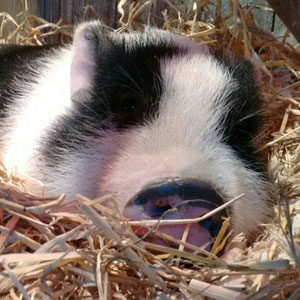
Many people adopt pigs as pets. They are easily house-broken and are affectionate – they love to climb on laps and get belly rubs. They can respond to human commands and will follow people on walks, happily wagging their tails. Some celebrities are photographed with “teacup pigs” as a fashion accessory because they are so cute. However, these “teacup pigs” grow into the pot-bellied pigs that are at Safe Haven (unless they are starved to keep them small) so many of these animals are abandoned as they grow bigger. Zoning laws prohibiting farm animals in towns result in other abandoned pot-bellied pigs.
In nature, pigs spend about 75% of their waking hours grazing, rooting, and exploring their surroundings. Pregnant sows will travel for miles to find the exact right conditions to build a nest for birthing. Some of them build two nests and then make a choice! Sows use twigs to carefully construct nests for their piglets. There has been no known case of a wild sow suffocating their piglets in these nests. They are constructed so if the sow accidently rolls on a piglet, the baby just falls through the nest and then joins the siblings for feeding [Stolba and Wood-Gush]. As they grow older, piglets join social groups to explore and play together.
Pigs in the wild will live for about 10 years. They will feed their piglets for about six months before weaning. They live in social groups and recognize up to 30 other individual pigs in their group. They even use sounds to communicate with each other. Pigs are clean animals and will move outside their nests and resting places for waste elimination.
Pigs’ genome is closely related to the human genome. We both have areas of hairless skin, heavy eyelashes, and protruding noses. New genetic analysis speculated that primates and pigs might share an evolutionary ancestor. Mother Nature Network said:
But it goes to show that our relationships to our animal brethren are often closer than first appearances may suggest. Despite the great diversity of life, there is a string connecting us all together — a string that geneticists are only beginning to learn how to unravel.
Did you know about the routine mutilation and slaughter of pigs?
In the US, over 100 million pigs are slaughtered each year for food. Despite the happy pigs shown on happy farms by pig producers, the reality is that:
- Animal welfare laws for farmed animals do not exist – minimal animal welfare laws only cover transportation to slaughterhouses and killing methods. The majority of states have no laws to cover treatment of animals on farms.
- Most states have anti-cruelty exceptions for common farming practices. This means that if a practice is done by most producers, no matter how cruel, the producers cannot be prosecuted.
Factory Farms
Over 95% of pigs used for human food in the US are raised in factory farms, where they never see the light of day. To say that these farms keep pigs from exhibiting normal behavior is an understatement. Here is the brief life journey of a typical factory-farmed pig:
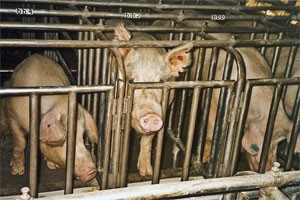
- Pregnant sows (after being forcibly impregnated at only 7 months old) are put in gestational crates. These are about 2 feet wide and about one foot longer than the length of their bodies. There are bars on the crates, no nesting materials, no opportunity for socialization, and no room to move or even turn around. Their floors are covered with feces and urine. Many sows exhibit signs of distress in these crates: biting the bars, biting their own tails, shaking their heads.
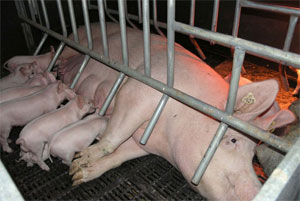
- Sows about to give birth are put into farrowing crates. The only contact the sow has with her piglets is when they suckle through iron bars. Producers claim that farrowing crates eliminate the death of piglets from sow suffocation, which happens when sows are not allowed to make their own nests. Many piglets die from starvation or diarrhea before being weaned at 2 – 3 weeks. Since 2012, the use of crates has been outlawed in the European Union, but only nine states in the US have banned them. New Jersey Governor Chris Christie, pandering for votes in Iowa’s presidential primary, famously vetoed a ban on crates, despite 93% of New Jersey residents in support of the ban.
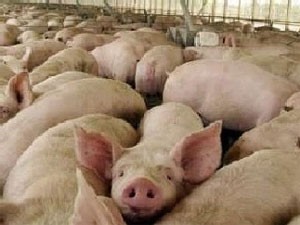
- After weaning, for the next six months pigs are crammed into huge sheds with no daylight. Excrement and noxious gases cause the pigs to develop respiratory distress failure.
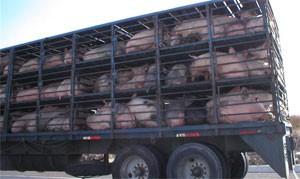
- Pigs get to leave the sheds for the trip to the slaughterhouse. Pigs are packed into trucks with no food or water for the up to 24 hour trip to the slaughter house. There is a high mortality rate during the trip – .17% of ambulatory pigs arrive DOA.
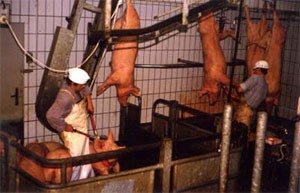
- According to Melanie Joy, here is what happens at the slaughterhouse:
They are prodded onto a narrow walkway or chute, on which they walk single file to the killing floor. The animals at the rear of the chute hear the screams of the pigs ahead …. Farm animals are supposed to be stunned and rendered unconscious before they are actually killed. However, some pigs remain conscious when they are strung upside down by their legs in shackles and they kick and struggle as they are moved along the conveyor belt to have their throats slit. Because of the speed at which the animals are supposed to be stunned and killed, and because slaughterhouse workers are often ineffectively trained, a number of pigs may also survive throat cutting and remain conscious when they arrive at the next station, where they are dropped into scalding water – a procedure done to remove their hair.
All of this suffering of sentient, sensitive, curious animals occurs because people like the taste of bacon.
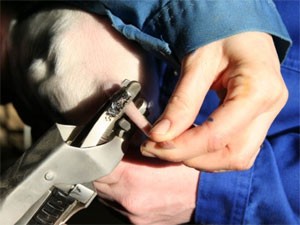
Artisanal, free-range, family-owned farms
The Animal Welfare Institute sets standards for humane farming so pigs should be able to engage in behaviors that are normal, such as living in social groups and nesting. Despite these minimal standards, piglets raised for human food are:
- Prematurely weaned (at 2 – 3 weeks);
- Have their tails cut off without anesthesia (tail docking);
- Have their baby teeth cut off;
- Males are castrated without anesthesia;
- If “free-range” (meaning access to the outdoors), pigs have ¾” nose rings inserted into sensitive snouts without anesthesia. Producers claim that without nose rings, pigs will root and dig up fields. These nose rings are excruciatingly painful to the pigs and keep them from performing natural pig behaviors.
- Slaughtered at age 4 months to 1 year old (unless they are kept for breeding before slaughter).
Some small farmers send their pigs to the same slaughterhouses as factory farms. Others prefer to kill pigs themselves and believe the flesh tastes better when the pig is bled out alive. A slit throat or a gunshot to the head prolongs the painful death so pigs’ own hearts pump blood out of their bodies for humans to have better tasting meat
So, you can think you are paying more for humanely raised dead pigs (aka pork or bacon), but you are actually perpetuating the torture and slaughter of innocent, curious, intelligent animals.
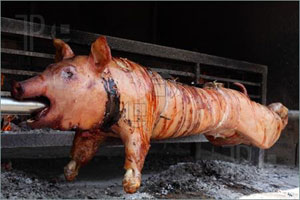
Did you know eating pigs is not good for you?
USDA estimates the average American eats 51 pounds of pigs per year [Joy, p. 36]. We seem to love our bacon, sausage, ham and pork chops. However, dead pig flesh does not love us back. Here are some known health risks from eating pigs:
- Pig flesh is high in cholesterol and saturated fat. This has been linked with heart disease, diabetes, arthritis, osteoporosis, Alzheimer’s, impotence, obesity, and asthma.
- The unsanitary conditions used to raise pigs (poor ventilation, overcrowding, and excrement) result in a pneumonia rate over 70% among pigs sent to slaughter houses. Pigs are given excessive amounts of antibiotics to promote growth and to keep them alive until slaughter. Antibiotic overuse results in super strains of bacteria that will not respond to known antibiotics that you might need some day when you are sick.
- According to Consumer Reports, 69% of tested pork is contaminated with dangerous bacteria which can cause gastrointestinal diseases such as diarrhea, vomiting and stomach cramps.
- According to the Center for Disease Control (CDC), over half the pigs on factory farms have H1N1 virus (swine flu). This disease can attack humans and cause death [Oppenlander, p. 79].
- China and the EU has rejected pork produced in the US because of high quantities of Ractopamine found in over 20% of samples. This drug is given to pigs (and turkeys) to increase growth. The human safety study quoted by pig producers about the safety of Ractopamine to humans included six healthy subjects who experienced elevated heart rates, increased stress, and difficulty walking while given the drug. The EU and China said this drug is not safe for humans, but US pig producers routinely use it.
- Other diseases related to pig consumption include Hepatitis E, Yersinia and tapeworms.
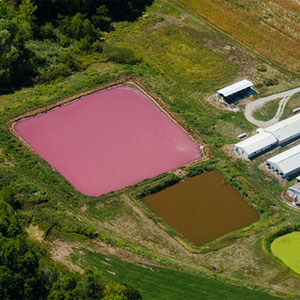
Did you know pig waste is a major source of pollution for our rivers and lakes?
According to the EPA, THE major source of pollution for our rivers and lakes is factory farm runoff (that is, the excrement and urine from factory farmed animals). This pollution is higher than all other sources of industrial pollution combined [Masson, p. 36].
In the US, human waste is carefully regulated, processed and monitored. However, no such standards exist for farm waste, which is 130 times greater by volume than all the human waste in the US. A typical pig farm generates as much waste as a city of 50,000 people. Here are some facts related to exposure to waste from pig farms:
- The Center for Disease Control (CDC) warns that people living near factory farm excrement lakes with high nitrite concentrations show high levels of spontaneous abortions and fatal baby blue syndrome.
- In 1993, Cryptosporidium from factory farms polluted Milwaukee’s drinking water, resulting in 100 deaths and 400,000 cases of illness.
- In 1998, National Institutes of Health (NIH) reported that 19 people died of sulfide emissions, which can also lead to respiratory tract infections or irritation and brain damage.
- Dead zones in the Gulf of Mexico are caused by algal blooms as a result of the animal waste that are now half the size of Maryland.
- Duke University has reported that people living near pig farms experience more depression, anger, fatigue, and confusion than people who have the wealth to move away from these sources of pollution.

Did you know you can make a difference?
You make a choice every time you sit down at the table. That bacon that you are eating comes from a very sociable animal raised in brutal conditions and then killed inhumanely at a young age.
Do you think that pigs matter? Do you think they have a right to simply exist and exhibit pig behavior? Do you think they can suffer? A simple way of showing your compassion for pigs is to simply refrain from eating them.
References
Strawn, Heidi, June 16, 2015, Pigs Just as Smart as Dogs and Chimps Study Suggests, Hobbyfarms.com, https://www.hobbyfarms.com/pigs-just-as-smart-as-dogs-and-chimps-study-suggests/
Joy, Melanie, Why We Love Dogs, Eat Pigs and Wear Cows, Conari Press, 2011.
Masson, Jeffrey Moussaieff, The Face On Your Plate: The Truth about Food, W. W. Norton & Co., 2009.
McWilliams, James, The Modern Savage, St. Martin’s Press, 2015.
Oppenlander, Richard, Comfortably Unaware, Beaufort Books, 2012.
Stolba, A. and D. G. Wood-Gush, The Behavior of Pigs in a Semi-Natural Environment in Animal Production, 1989, volume 48, pp. 419-425.
